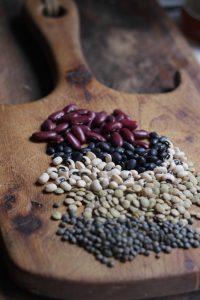As the weather starts to cool down, the big pots come out of the cupboards and soups and long cooked casseroles and stews become more attractive. Legumes or pulses have nourished humankind for centuries and are a great nutrient-rich addition to cool and cold weather meals. In order to reap the nutritional benefits encased in these little parcels we to need to take heed of these preparation principles.
Ingredients
legumes or pulses
water
Optional ingredients:
sea vegetables such as kombe or wakame or green weed leaves such as dandelion, chickweed or nettle – see tips below.
Method
Legumes or pulses have nourished humankind for centuries and are a great nutrient-rich addition to cool and cold weather meals. They are also extremely economical, if you purchase them dry and take the time to prepare them correctly. Traditional societies, which base their cuisines on legumes, take great care with their preparation.
In order to reap the nutritional benefits encased in these little parcels we to need to take heed of these preparation principles, otherwise their rich mineral content, B vitamins and omega fatty acids will remain locked away and the only gift we receive will be an uncomfortable, gassy belly.
Beans require long periods of soaking – at least 12 hours, 18 is even better. The longer you soak them, the more digestible they become. Change the water a couple of times during the soak period and don’t worry if they start to ferment a little, or sprout – they will only be even more digestible.
Discard the soak water and rinse the beans, in some cases (e.g. chickpeas), you may wish to pick off the outer skins.
Cover the soaked beans with plenty of water and bring to a boil. As the beans are cooking, foam will rise to the top of the pot and this needs to be carefully skimmed away.
Add more water as needed to keep the beans covered till they are cooked. Sometimes the cooking water is even replaced part-way through the cooking to further dilute the anti-nutrients. When beans are properly cooked, you should be able to easily squish them by pushing them to the roof of your mouth with your tongue. They shouldn’t be at all crunchy or al dente. These essential steps ensure the legumes will be digestible, and the nutrients they provide absorbable because the phytic acid (a compound that binds to important minerals and inhibits digestive enzymes) and enzyme inhibitors will be neutralised, and the complex (difficult to digest) sugars will begin to break down to more easily digested forms.
Other tips for cooking beans properly include:
• Adding sea vegetables: kombu (if you can find it – its sale is banned in Australia but it is available in some Asian shops if you can read the labels) or wakame (available at the Co-op) helps further reduce phytates, increasing digestibility and mineral absorption.
• Adding a handful of green weed leaves such as dandelion, chickweed or nettle can improve mineral assimilation in beans.
• Never add salt at the beginning of cooking as this hardens the skins. Season your pulses after they have cooked.
• Acidic environments can lengthen cooking times and toughen the skins of pulses. Metal pots, tomatoes, vinegar etc can contribute to an acidic environment.
• Adding ¼ tsp bicarb per 500 g of pulses in the soak water, or at the beginning of cooking, will help to soften the beans more quickly, dramatically reducing cooking time, but will also destroy B vitamins, and affect the flavour of your beans so this is only recommended for occasions when you have a short preparation time or are using old, very dry beans.
By Danielle O’Donoghue



